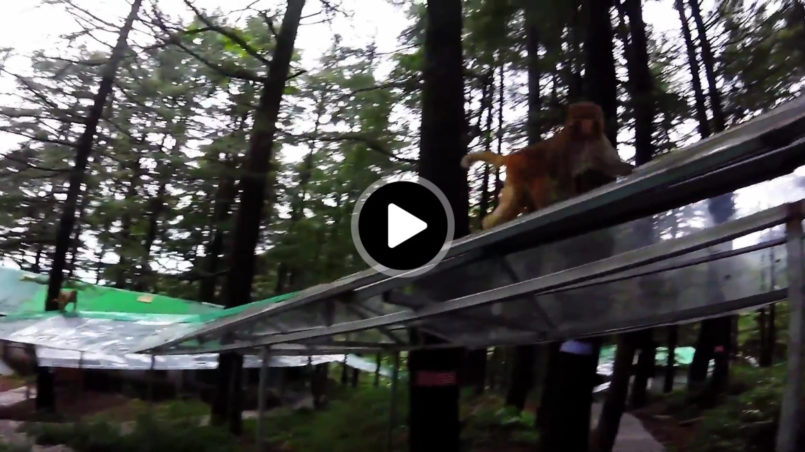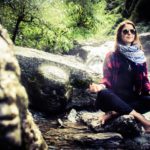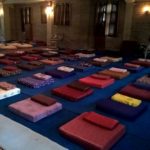Not talking for ten days
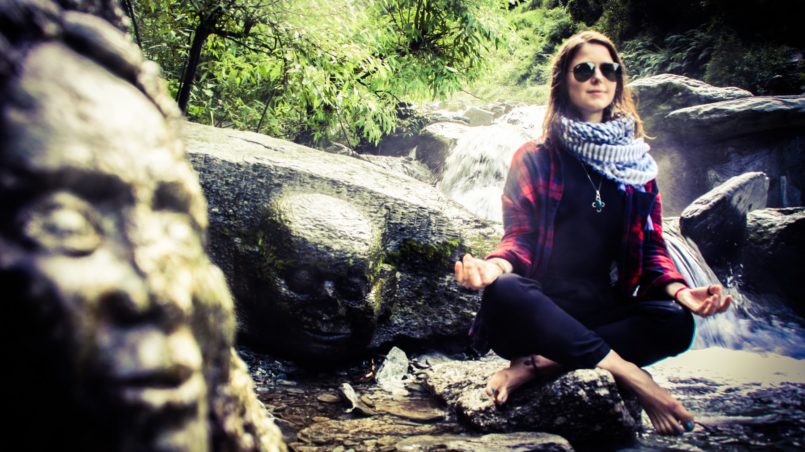
The first time I have heard about Vipassana, was from a friend of mine who had attended one of the courses some time ago.
Vipassana is an ancient silent meditation technique and means to see things objectively and as they really are.
It is not only a technique, moreover it is an Art of Living, which was introduced by Gautama Buddha, more than 2500 years ago. The aim is the purification of one’s own mind, by eradicating all the deep rooted impurities and eventually achieving a state of so-called full liberation:
A balanced mind, free from all miseries – full of love and compassion.
Everyone, regardless which God one believes in, is welcome to try this wonderful Dhamma. Dhamma, in Pali scriptures or Dharma in Sanskrit language, has various meanings but is mostly used as the natural law which defines the social, moral and spiritual harmony of your life; it is as well used to describe the truth, teached by Buddha.
As my friend told me about his experience and that you aren’t allowed to speak to anyone for 10 days, I thought that it is crazy and that I would never be able to complete such a thing. Although, as much as it scared me, it also awakened a curiosity in me and I was interested in finding out more about it. A few months later it was still in my head and I started reading and researching about it. I found out about a documentary movie called: „Doing time, doing Vipassana (1997)“.
The movie speaks about the largest prison of South Asia, the Tihari prison, situated in New Delhi, India. The first female prison inspector of the Tihari prison had the idea to introduce Vipassana among the prisoners – as it is a way of self-transformation through self-observation and helps to control your life, your mind, gain harmony within yourself and simply become more balanced, therefore more happy.
She is from the believe that by treating the inmates like “animals” – in inhuman ways – they will never be able to reintroduce back into society and will be coming out of prison perhaps even more “evil” than before entering prison.
She wanted to give them the possibility to go on this spiritual journey of self-transformation and seek inner peace within themselves.
She invited Mr. S.N. Goenka – a former business man from Burma/Myanamar who brought this meditation technique to India in 1969. He, himself, was suffering for many years from severe migraines and seeked help from different doctors worldwide – but nothing helped. After some time he attended a Vipassana meditation course and that changed his life completely. He devoted himself to this technique and started financing many centers worldwide, where one can attend a 10 day meditation course based merely on donations from old students who already completely a course -, who came and held the course at the Tihari prison.
At that point, no one knew what outcome Vipassana would have among the prisoners but fortunately it was great. Many inmates attended the course and worked very hard, calm and patiently. Because it showed such positive results, from that moment on until today, two 10-day courses are being held every month in the Tihari prison, and the Indian Government decided to apply Vipassana in all country prisons. Shorter courses, of 3 days, started to be held as well in schools – promoting better concentration among children of various age groups. Other countries started to follow this example and became interested in spreading Vipassana among prisoners as well.
After I had seen this movie, I took the decision of trying this technique myself. I found out that there are multiple courses, offered all over the world, in very peaceful places among nature and based only on donations. Even though most courses offer place to about 100 students or more, 50 female and 50 male – strictly separated – there is still a very high demand and therefore, you have to subscribe early to get a place: https://www.dhamma.org/en/index
In the past I applied for various courses, but always resigned again some time before, as it was never the „perfect time” to renounce everything for 10 days, being locked away from society with no contact to the outside world. I was also scared, in one way or the other, what this meditation would do to me and if I’d go crazy by not speaking to anyone for such a long time.
Finally, one year later – now -, the perfect time has come and I apply for the course in Dharamkot/Dharamsala (Himachal Pradesh, North India), situated in the Himalayan mountain range. I think this would be the perfect place for the mediation since already the name of the town means spiritual dwelling (Dharam = religion and shala = sanctuary) and it is also very close to the home of the Tibetan spiritual leader, Dalai Lama. I have a good feeling about this and understand why it didn’t work out anywhere else previously.
I arrive there on a rainy day and go up the stairs to reach the center which is surrounded by the amazing mountains of the Himalayan range and tall pine trees, offering a peaceful atmosphere quite shed off from the outside world. As I sign up, the volunteers tell me the rules again: Alcohol, cigarettes, external food, other distractions like books, music, writing materials etc., electronics or sexual contact, are prohibited. You have to keep strict noble silence for the whole course period, which means that you are not allowed to speak to anyone, as well eye contact and physical contact are to be avoided. The only person you can speak to is the teacher, regarding the understanding of the meditation technique and only on certain hours of the day.
After they explain all the rules, they ask one more last time if I am willing to accept and follow them for the next days and behave accordingly. I feel like signing up for prison voluntarily, since they say that once you are in the center you are not allowed to leave anymore, and I am still in the dilemma about how not to speak to anyone for 10 days.
But I answer with a clear YES.
I make the last important phone calls and put all my belongings in the provided lockers. As I get the key to my accommodation for the next 10 days I enter to the actual center area; a nice peaceful trail leads me to the house D4. Every house is protected with a fence, forming a so-called cage and reminding kind of at a prison, since the meditation center is also the home to a monkey troupe which can be potentially dangerous from time to time.
I open the door and enter into a very simple room, offering 4 beds with very thin mattresses, each one divided by a wooden wall to offer more privacy but no doors. I meet my roommates for the next time: three Indian women from different parts of the country and different age groups.
As this is the introduction day, we are still allowed to talk to each other and it is nice to share each others thoughts.
At 5pm we go to the dining hall to have dinner; it is rather a snack – puffed up rice with peanuts, cookies and milk tea – and they inform us about the daily schedule we have to follow: wake up time at 4 am, sleeping time at 9 am, breakfast at 6.30 am, lunch at 11 am, light snack at 5 pm (no dinner).
In between, strict meditation, with some rest time after each meal and in the evening video discourses, which explain the meditation technique profoundly, are shown. Out of curiosity, I look around me and see women and men from all different age groups and different nationalities: Indians, Russians, Europeans, Australians … I speak to one or the other person and realize that as soon as we are going to leave the dining hall the noble silence will start. No more talking …
I am extremely tired so this night I fall asleep immediately and sleep like a baby…
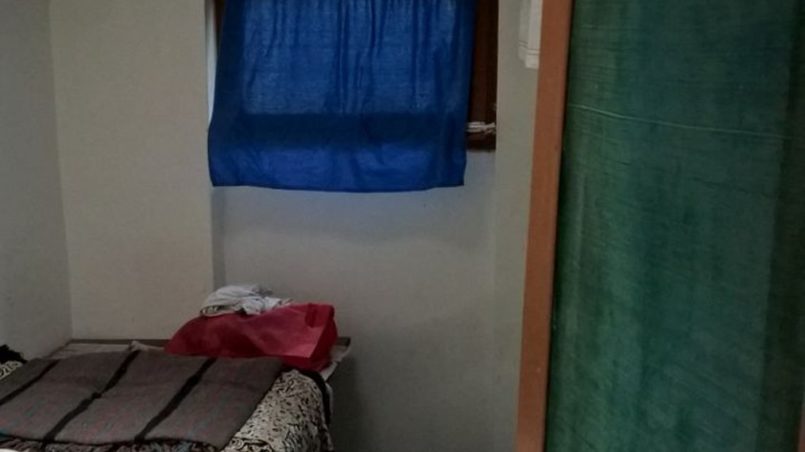
The next morning, at 4 am, I hear a loud Dong – the wake up bell -, and afterwards the ringing of a smaller bell. It reminds me of the bell my parents used during Christmas time, in order to make us children understand that the Christkind – the traditional gift-bringer – had come, since the so-called „Dhamma servers“ (volunteers) go from room to room to make sure that everyone is waking up. I am starving as I had my last food 12 hours ago, but it is time for meditation – still 2.5 hours more until breakfast. We go to the meditation hall and get introduced to the technique, called Anapana – by listening to audio recording from S.N. Goenka.
He explains that we should concentrate on our breath – among the triangular area of the nose (the top part being the point between the eyes and the base being below the nostrils, above the upper lip) – as it goes in, as it comes out – by observing the natural float of air objectively and trying to feel the touch of air to understand whether it is expelled from the left, the right or from both nostrils at the same time. Initially it is very difficult to do so, because many thoughts were passing through my mind: about the past and the future, everything else, just not about the present moment – the meditation.
We humans really have one wild mind, almost like a wild animal – a wild monkey, which is so difficult to tame.
If you start to have negative feelings about not being able to concentrate, the more difficult it will become; you have to accept your wild wondering mind and come back to meditation smilingly.
As soon as I hear the chanting I knew it was breakfast time and get up very quickly to reach the dining hall.
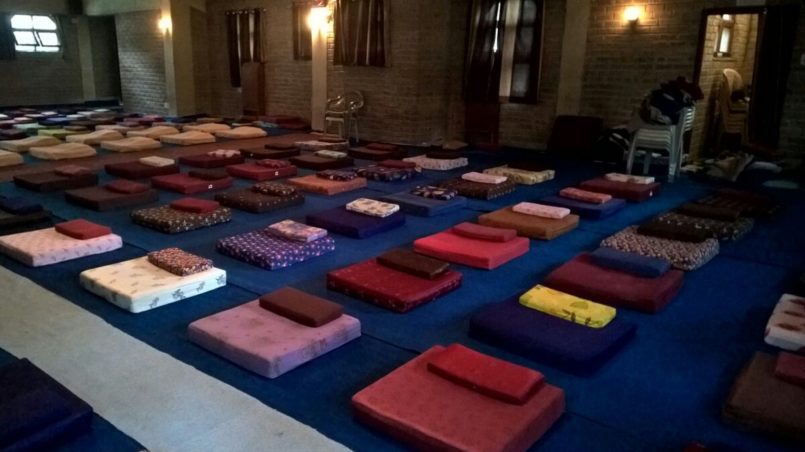
The food is, to my surprise, very good; for breakfast we have: different fruits, milk tea, dry bread, toast or cornflakes and you can get as much as per you requested. After breakfast we can take some rest time and at 8 am meditation starts again, the group sitting – where everyone has to be present in the meditation hall and no one is allowed to leave during that hour. We start again to concentrate on our breath and as soon as I know it I hear the chanting – the so-called meditation bell – and realize that it is lunch time.
Time really flies while meditating.
For lunch vegetarian – Buddhists and Hindus don’t eat meat as they are against the killing of any animal – Indian cuisine is offered: fresh salad, rice and lentils soup, cooked vegetables, chapati (flatbread from India) and sometimes curt (Indian yogurt), paneer (Indian cottage cheese) and different kind of sweets. It is nice as it is alternating every day. During eating times we have to sit down in a way not to look at anyone, either facing the wall or facing the window. Initially it is weird to eat in a room full of people and not to look or speak to anyone but after some time I get used to the presence of only myself and I must say that I actually start enjoying it.
I mean, when will it ever happen again that I have the chance not to communicate with anyone, without being considered an antisocial person or a weirdo?
In the afternoon, after lunch, I go for a walk and start to observe the nature: There are a lot of snails, cats and dogs but the most interesting for me are the wild monkeys. There must be like a hundred of them and they are running around through the center all day long. It is very nice to be able to be so close to them and just observe their natural behavior. We get advised not to stare into their eyes since they can feel threatened and not get to close to them since there have been incidents of attacks.
At 1 pm meditation starts again. This time we can choose whether we want to meditate in our own cells or in the Dhamma (meditation) hall. I choose the meditation hall, since by meditating in my room I would probably just fall asleep. At 2.30 pm we have again a mandatory group sitting for one hour and at 3.30 pm the teacher asks everyone individually how the meditation is going so far and clears any existing doubts. As soon as it is 5 pm we head towards the dining hall to take the last food for today: puffed up rice with fried peanuts, cookies and milk tea; old students (who already completed one Vipassana course) are only allowed to drink ginger tea.
At 6 pm we have the last group sitting and after that we watch the video discourse of Mr. Goenka, who explains everyday into details. He gives me a lot of motivation, as he talks about the struggles he was having while meditating for the first time, for example that he wanted to escape from the center etc. and by making me realize that I am not struggling alone, but everyone is going through the same thing. Moreover he is also extremely funny, tells a lot of stories and everyone is having a good time while watching their videos. Just before going to bed, a 9 pm, we have the chance to ask the teacher some questions about any doubts.
For me, the most difficult part of the day, is during night, more precisely during bed time. I just lay in my bed – eyes wide open, not tired at all and thoughts running in all different directions and there is absolutely nothing to do: no movie, music or book. Once I go outside for a walk but get sent back into my room immediately as it is sleeping time.
The next day we have to concentrate on an even smaller area – the area around and below our nostrils. Working on a smaller area helps to make the mind sharper and to feel the touch of air even more intense. By being attentive you start to notice and feel sensations that you didn’t even know were there previously. Even if it is only a small improvement – a baby step – I can notice that the second day and every new upcoming day is better then the previous one; the mind gets more quiet, more calm – the thought pattern starts to change step by step.
As day 4 arrives we are introduced to the actual Vipassana method. The breathing method is just a technique to make the mind adapt, make it calm and make it sharper in order to feel all the different sensations which are running through our body in every moment of time. Sensations are always present in our body, and there are so many different kinds of sensations e.g. subtle, gross, pleasant, unpleasant … But they all have one thing in common:
They are impermanent: As they arise they will go again.
Practicing Vipassana means observing one’s own sensations – from head to toe and toe to head, every single body part – in an objective way. This means, observing the sensations (the reality) as they truly are and most importantly without reacting to them. The teachings of Buddha (Buddha means nothing else than the enlightened one, it is the highest spiritual stage that a human being can achieve; technically, everyone, can become Buddha) say:
“Don’t dance when feeling pleasure and don’t cry when in vain. Only by keeping an equilibrium of one’s own mind, one will be free from misery.“
What he means is, that by observing reality as it is, without wanting to change it and without reacting to it, whether something bad or something good happened in that specific moment of your life and by understanding one important thing, which is that, “also this will pass” as nothing is permanent, you will get rid of your own misery and live a balanced life. If you go through a difficult period in life tell yourself smilingly also this will pass, as nothing is permanent. Whether a sensation is pleasant or unpleasant: cold, warm, itching, pain, electric current etc. one should not crave or avert any sensation with the understanding that every sensation is impermanent.
He found out that by objectively observing one’s own sensations and not reacting to them, as our subconscious mind was used to do, one will be liberated from all the old miseries – Sankara, which means old reactions towards things -, as they will come to the surface and be eradicated. And by not craving or averting any new sensations, you will not create new Sankaras (reactions), new miseries. Eventually this will lead to the stage of full liberation of one’s own mind; also by fulfilling all the qualities of the 10 virtues (parami):
- nekkhama (renunciation)
- sila (morality)
- virtya (effort)
- khanti (tolerance)
- sacca (truthfullness)
- adhittana (strong determination)
- panna (wisdom)
- uphekka (equanimity)
- metta (selfless love)
- dana (generosity, donation)
Obviously one will not manage to be perfect in one day, but this is the concept, and by practicing every day it will have positive effects on your life and you might even see improvements in one or the other paramita (virtue).
Initially, again, the mind keeps wondering away with every little distraction; whether someone is coughing or sneezing, monkeys are passing over the roof, the rain is dripping (which happens every day, since it is monsoon season, actually offering a nice and relaxing atmosphere during the meditation) or just a light beam is coming through the window, every occasion is good enough to think about something else. Mostly memories about my childhood are arising, memories that I didn’t even remember clearly. It is very nice and I enjoy it to see certain pictures of my childhood, almost like a movie passing in front of my eyes.
I can even hear someone crying, letting all the emotions out, as he or she must relive a traumatic or maybe even a happy memory. Throughout the meditation I start to realize that my senses are more awaken – I am able to smell and hear things much more intense than before, every sound is very clear. I also notice, that in those moments where I do manage to switch off my mind, fully concentrate to the present moment and devote myself to the meditation I am fulfilled with a wonderful, very unknown, unique and pleasant feeling. It feels almost like a pleasant current running through the body and charging it with a lot of energy.
From day 4 onwards we have, three times daily, 1-hour group sittings where you are not allowed to change your posture or open your eyes. This group sittings help to improve one of the 10 virtues, the one of the strong determination (adhittana).The first time it is extremely difficult, after about 30 minutes my legs start to burn and after approximately 45 minutes it feels like they are on fire. The last 15 minutes are pure torture as I have never sit crossed leg for 1 hour straight, ever before in my entire life. I am very close to cry out of pain and therefore, I crunch my teeth and try to concentrate just on my breathing – making loud and heavy breaths. Somehow I manage and as I finally hear the chanting (which means that the one hour has passed) I am extremely relieved. In that instant I thought that I will not be able to do this three times a day, no way, and I am wondering if anybody else feels the same way I do as I am not able to see what is happening around me or to speak to anyone.
Isn’t it funny how our mind works? Whenever we feel something unpleasant, like for example pain, every second – every minute, feels like an hour; whereas if we feel something pleasant time just flies away in a blink of an eye.
That evening, as we attend the video discourse – which helps in understanding the whole concept better, I get a better understanding about the technique and feel a little bit more positive towards the strong determination method. The next day I try again and as explained from Mr. Goenka, I start to objectively observe the pain I am feeling without reacting to it and magically, I manage to sit for one hour straight without suffering – I can obviously still feel some pain but it is nothing in comparison to the first attempt. I am extremely surprised by this fact but it really works:
The less I react to the pain the less it bothers me.
By practicing this technique day by day I can feel that my mind is getting more calm and actually it is more easy to concentrate and live in the present, instead of constantly having thoughts about the past or the future – the future after all is either just dreaming about something which hasn’t happened yet and maybe never will and the past is something which we cannot change anymore, they are just memories.
The last day, day 10, is a shock-absorbent day, meaning that after half a day has passed we are allowed to speak to each other and also get our phones back. It is very interesting to hear and share about different experiences from the other meditators, finding out for the first time that I am not the only one struggling and also that not everyone has managed to keep noble silence throughout 10 days; actually the majority of women started to speak maybe halfway throughout the course.
This is also the day when I understand why we are advised to keep noble silence; it is because every time you interact with someone and you hear the experience of another person regarding the meditation, you will seek for the same and think about those things during your meditation. For example if your roommate is experiencing a free float of energy and I am not, I will think about this and I will crave for this sensation during my meditation and at the end it is going to be counterproductive.
The second part of the day consists in learning the technique of selfless love (metta) where you have to sit down in a comfortable position and open your heart to the world, to all beings, sharing the love and the compassion you have within you. As we do this, I can really feel how the room is lighting up with such a positive energy and we hear Mr. Goenka say, one more last time:
“Bhavatu Sabba Mangalam”, which means as much as may all beings be happy and we reply with: “Sadhu”, yes, we agree.
The course ends in the morning of the 11th day.
Note: The following video was shot during my last day at the meditation center, since we were not allowed to carry electronics, and I hope it helps to give an insight about the location.
I guess the most important questions that you might be interested in are the following:
Did this course help me to find myself?
No, it did not. I don’t believe it is about finding yourself – I rather believe it is about creating yourself – a new self. I started asking myself questions like: “Who do I want to be?” , “Do I want to be the person who gets angry or irritated fast or do I want to be the person who expresses peace and harmony?”. As soon as you know, who do you want to be and what you need to change to get there – you can start working on that.
Sometimes people tend to put themselves in a box and believe that if they have any fear, like for example being scared of heights (or anything else), they will keep that fear all life long, but NO.
We constantly evolve and have the possibility to change in every moment of our life – the person I was five years ago (or maybe even the person I was last week) is not the same person I am now. Every new experience we make in life will change us in some way or the other so I personally believe that we can learn from every new experience – good or bad.
Would I do this again?
Yes, I definitely would do it again. I have learnt the meditation technique and without attending such a course and being in such an environment I would have never managed to meditate in this way for 10 days. Obviously a 10-day course will not bring miracles to my life, no, it showed me how I have to work and now it is on me, and on anyone else who learnt the technique, if I practice it or not. It is advised to meditate one hour in the morning and one hour in the evening every day, it might seem much but honestly time flies while meditating and one also needs less sleep.
How was my experience?
Overall it was very good and I am really grateful I attended the course; obviously some moments were frustrating and difficult, as 10 days is quite some time. When I didn’t succeed in the meditation I got frustrated and thoughts like: “Now is not the right time to do this, I will come back after a few months or maybe a year”, were passing through my mind, but I knew that I had to push myself through – show determination – as this hard work is part of the journey, and getting frustrated is exactly what I should avoid.
The thing what I was the most scared of was the non-speaking part but I must honestly say – I was surprised as well:
After some time I really enjoyed not speaking to anyone, it felt kind of like a relief, like a liberation.
I am sure that by practicing this technique I can achieve wonderful results, as for example being more calm, patiently, making better use of my time and concentrating better.
By practicing Vipassana and by getting the positive changes it has to offer, the environment around oneself will feel the effects as well – one will start to express harmony all around. It is just like the same when someone is laughing – other people around will also start to feel the good vibes – they feel happy.
My advice to you is, that if you want to do something good for yourself, to do something different and completely switch off for some time – just enjoying nature and spending time with yourself, not having worries about anything – then you should definitely try this out. It will have one or the other positive effect on you – for sure and even if you don’t like it:
The worst that can happen is, that you spend 10 days without being a slave of your mobile phone – and how bad is that really after all?
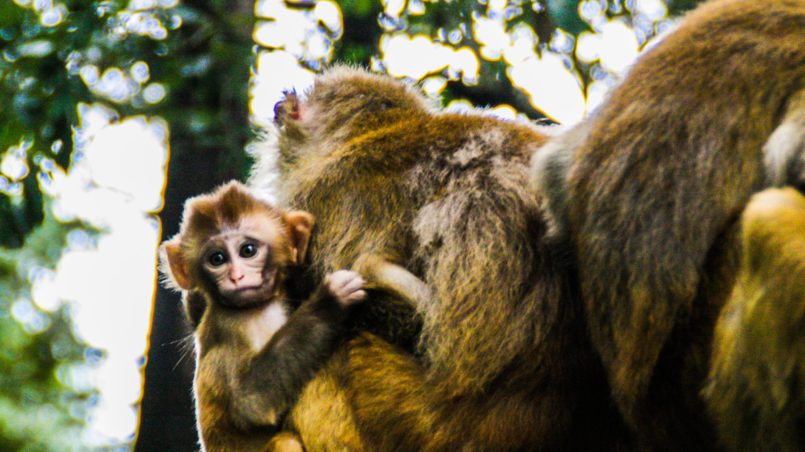
Namaste and Bhavatu Sabba Mangalam

